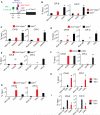SATB1 Expression Governs Epigenetic Repression of PD-1 in Tumor-Reactive T Cells
- PMID: 28099864
- PMCID: PMC5336605
- DOI: 10.1016/j.immuni.2016.12.015
SATB1 Expression Governs Epigenetic Repression of PD-1 in Tumor-Reactive T Cells
Abstract
Despite the importance of programmed cell death-1 (PD-1) in inhibiting T cell effector activity, the mechanisms regulating its expression remain poorly defined. We found that the chromatin organizer special AT-rich sequence-binding protein-1 (Satb1) restrains PD-1 expression induced upon T cell activation by recruiting a nucleosome remodeling deacetylase (NuRD) complex to Pdcd1 regulatory regions. Satb1 deficienct T cells exhibited a 40-fold increase in PD-1 expression. Tumor-derived transforming growth factor β (Tgf-β) decreased Satb1 expression through binding of Smad proteins to the Satb1 promoter. Smad proteins also competed with the Satb1-NuRD complex for binding to Pdcd1 enhancers, releasing Pdcd1 expression from Satb1-mediated repression, Satb1-deficient tumor-reactive T cells lost effector activity more rapidly than wild-type lymphocytes at tumor beds expressing PD-1 ligand (CD274), and these differences were abrogated by sustained CD274 blockade. Our findings suggest that Satb1 functions to prevent premature T cell exhaustion by regulating Pdcd1 expression upon T cell activation. Dysregulation of this pathway in tumor-infiltrating T cells results in diminished anti-tumor immunity.
Copyright © 2017 Elsevier Inc. All rights reserved.
Figures







Comment in
-
Satb1: Restraining PD1 and T Cell Exhaustion.Immunity. 2017 Jan 17;46(1):3-5. doi: 10.1016/j.immuni.2017.01.002. Immunity. 2017. PMID: 28099863
References
Publication types
MeSH terms
Substances
Grants and funding
LinkOut - more resources
Full Text Sources
Other Literature Sources
Molecular Biology Databases
Research Materials

